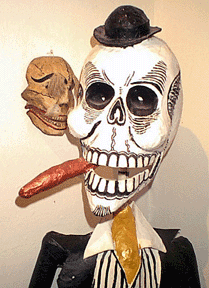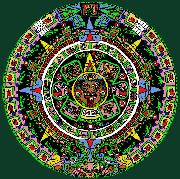LOS CABOS:
EL HALLOWEEN AND THE
DIA DE MUERTOS
by
C.M Mayo
 Today was the Día
de Muertos, that tradition —
the local pundits claimed — so in need of rescue from "foreign
influences." A blend of European folk practice and pre-Hispanic
ritual adapted to the Catholic All Souls’, it is celebrated in
mainland Mexico as a happy day. Today was the Día
de Muertos, that tradition —
the local pundits claimed — so in need of rescue from "foreign
influences." A blend of European folk practice and pre-Hispanic
ritual adapted to the Catholic All Souls’, it is celebrated in
mainland Mexico as a happy day.
Families visit the graves of relatives,
sweeping and then decorating them with flowers, candles, and offerings
of food — tamales, chocolate, beans, and tortillas. In some parts of
Mexico an altar with the offering is assembled inside the house, and may
include photographs, favorite toys, musical instruments, and even
clothing. Until recent years this celebration was an intimate one, the
dead honored by those who knew and loved them. Now tourists, both
Mexican and foreign, crowd into the mainland Indian towns of Mixquic and
Pátzcuaro, jumbling through the narrow rows between the pretty graves,
cameras clicking away. "Mexico has sold its cult of death,"
writes Mexican critic Carlos Monsiváis, "and the tourists smile,
anthropologically satiated." Even the urban middle and upper
classes — in generations past, at a careful remove from the indigenous
— revel in their mexicanidad, assembling altars to no one in
particular, loudly colorful constructions for the lobbies of museums,
offices, shops and hotels, schools and universities, and town plazas...
On my way back from the airport I stopped in San José's. A hot
afternoon. Trees thick with birds. An old man sat nodding on the steps
of the church, which was a pretty little building, buff-yellow and cream
with twin bell towers flanking its entrance. In front of the ice cream
stand, a tourist in a golf hat and cork-soled sandals fanned himself
with a folded brochure. At the far side of the plaza, I found one Día
de Muertos altar, half assembled
in the shade of a lush, feathery palm.
Like all the many others I had seen, it looked impersonally
attractive. A riot of color and pottery (from Puebla and Michoacán), it
beckoned the camera, its chief purpose to win a competition.
I almost didn't notice that the little paper cutout
skull taped above a bowl of apples and bananas read: AMELIA WILKES
*****
At the mention of the name
Amelia Wilkes, the town historian, don Fernando Cota, rocked back in his
chair. "Ah, la profesora," the schoolteacher.
He'd been stroking dog, Solovino, behind the ears; now he laid both
hands Buddha-like across his belly and closed his eyes for a moment
before he began.
"Amelia Wilkes — Wilkes is a name like Ritchie
or Fisher, from a sailor — was born in Cabo San Lucas in 1907 and died
in 1989 at the age of eighty-two. She was a teacher and a community
leader. She served as president of the electricity supply, she directed
the water commission. This was around 1930, a long time before the chubasco.
When they named Amelia Wilkes subdelegate for the territory, she became
the first female authority in Baja California Sur. She was un
personaje, a real character, very respected. They dedicated the
plaza of Cabo San Lucas to her in 1976.
"I'll tell you a story that shows you what kind
of person she was. She used to collect money from the townspeople in
order to buy heating oil for the generator that produced the town's
electricity. She would buy the oil and keep it in barrels in her house.
Her house was made of wood. This was after the chubasco; it was
one of those from the governor. She was also the director of the school,
so she had all the savings of the students in her house, along with the
barrels of heating oil. One night her sister knocked over a kerosene
lamp, and the house caught fire. As fast as they could, so the house
wouldn't explode, Amelia and her sister began rolling out the barrels of
oil. And then she ran back into the house — the flames were
everywhere! — and grabbed the children's savings. That was what she
rescued, nothing of her own. She lost everything."
Excerpted from Miraculous
Air: Journey of a Thousand Miles through Baja California, the Other
Mexico
© C.M.Mayo, University of Utah Press, 2002
Published by permission
of the author. All rights reserved. This excerpt may not be posted
elsewhere or reprinted without permission of the author. For more
information, visit the author's Web site. |

